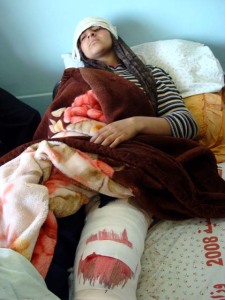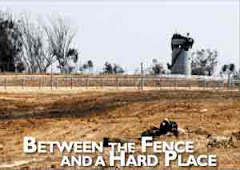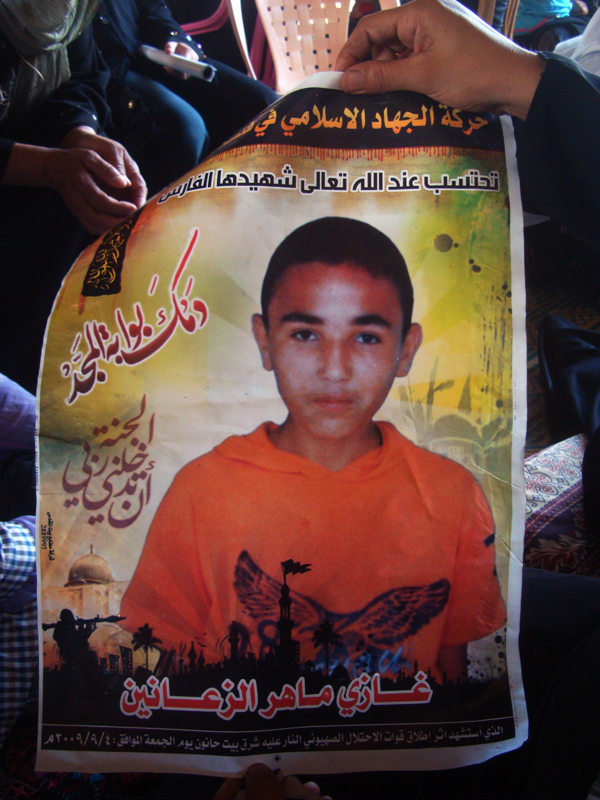“She was standing in the wheat field near her demolished home, about 800 m from Green Line border, when Israeli soldiers began shooting. The first two bullets hit the ground near her. The third hit her in the kneecap,” Wafa al Najar’s mother explained, sitting on an empty hospital bed next to her injured daughter.
We’d left Khoza’a after having been shot at by Israeli soldiers again -these shots, within one metre, the closest so far. The thought of the few desperate farmers who might try to go back on land worried me; I remembered Mohammed’s words about having no other choice, needing to risk it in order to provide for his 2 children and wife.
Fida’s text came some hours later: “A 17 years old girl from Khoza’a got injured 2 hours ago. Her name is Wafa Jehad al Najar. She got shot in the leg.”
In fact she was shot in the knee, she was ‘kneecapped’ as they say. The cavity of her former knee peeked through white bandaging soaked with blood. Wafa lay in Khan Younis’ Nasser hospital, moaning, sobbing, in pain.
Her family took turns relating the incident of her handicapping.
“We’d gone to see our house. It was demolished during the war. We’d hadn’t been close to it yet, we thought today was safe.” her mother explained. A neighbour agreed that it seemed safe, quiet. “I was in the area before Wafa was shot. It was calm, there was nothing going on, no reason for Israeli soldiers to shoot.”
Amal al Najar, Wafa’s mother, said she’d thought Wafa was martyred. “She had gone ahead. I was shouting to her, ‘come back, come back’. When she fell down I thought she was dead.”
Another martyr, she’d thought. Amal’s 20 year old son, Thaer, was killed in the first days of the attacks, shot in the head by Israeli soldiers. A week later, in a Cairo hospital, he died of his injuries.
Shadi, Wafa’s 25 year old brother, said the shots came from an Israeli soldier perched on one of the jeeps at the border fence. “I was near the house, maybe 300 metres away from Wafa and 900 m from the border,” he said. “When I heard the shots and saw her fall, I ran to Wafa, took off my t-shirt and waved it as a white flag. The soldiers shot at me. I lay on the ground, waiting for them to stop shooting. I called an ambulance. I waited about 10 minutes, and the jeep backed away. Then I picked up Wafa and carried her until we got to a place where the ambulance could reach us.”
The al Najar’s home is one of 14 destroyed in the war on Gaza in their area of the small village alone. In the greater Khoza’a area, 163 houses were destroyed by invading Israeli forces during war on Gaza. Another 1,500 m agricultural land was destroyed, razed and torn up by Israeli tanks and bulldozers, bombed and burned by shelling from Israeli F-16s and tanks.
For Amal al Najar the house was a long-time investment and sudden loss. “It took 8 years to build our house. We lived only 9 months in it before they destroyed it.”
We are aware of the Israeli soldiers’ daily shooting on Palestinians in the fields of the “buffer zone” but the residents of the Khoza’a region enlighten us to the tactics of shooting at children.
“Everyday they shoot when the children are going to or coming from school. Everyday children are crawling on the ground because Israeli soldiers are shooting at them.”
The “Khoza’a Martyr’s school” - named after the number of martyred from the Khoza’a region in the past 5 years: 113, not including the 25 further killed in Israel’s war on Gaza -was built some years ago to serve the students who until then had had to walk or travel 8 km to the nearest school. The new Khoza’a school has roughly 380 girls, 400 boys, and 800 pre-schoolers, and is about 1km from the Green Line. It is subject to a startling amount of targeted fire from the Israeli soldiers patrolling the border fence.
“There are two shifts for the students,” another neighbour, Ahmed, explained. “The students go to school at 6:30 am and at 2 pm.” But the soldiers apparently shoot whenever they find someone on the road leading to and from the school.
Ahmed elaborated on the level of violence in the area, which he says is high. Before the December/January war on Gaza, the Israeli army had already bombed the school twice, he said, and had occupied it numerous time in invasions.
Children aren’t completing their studies, we are told. They are too scared to stay at school long, just do a few courses here and there.
Drifting from the subject of invasions and Israeli gunfire, another Khoza’a resident gushed about the area. “It was a calm region, a great place to visit,” he bragged. “The families here are close, help one another,” he said, saying that this contributed to the general feeling of tranquility that visitors to the village enjoyed.
Khoza’a is left with a distinct absence of and longing for that tranquility, longing for the days when they could walk freely in their fields, yield a decent harvest, enjoy their small region of a very small Strip.







